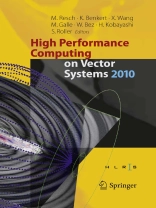This book covers the results of the 11th and 12th Tera?op Workshop and continued a series initiated by NEC and the HLRS in 2004. As part of the Tera?op Workbench, it has become a meeting platform for scientists, application developers, international experts and hardware designers to discuss the current state and future directions of supercomputing with the aim of achieving the highest sustained application perf- mance. The Tera?op Workbench Project is a collaboration between the High Perf- mance Computing Center Stuttgart (HLRS) and NEC Deutschland Gmb H (NEC HPCE) to support users to achieve their research goals using High Performance Computing. The ?rst stage of the Tera?op Workbench project (2004–2008) c- centrated on user’s applications and their optimization for the 72-node NEC SX-8 installation at HLRS. During this stage, numerous individual codes, developed and maintained by researchers or commercial organizations, have been analyzed and – timized. Several of the codes have shown the ability to outreach the TFlop/s thre- old of sustained performance. This created the possibility for new science and a deeper understanding of the underlying physics.
สารบัญ
Operating System and Software for Large Scale Systems.- Light-Weight Kernel with Portals.- Towards an Architecture for Management of Very Large Computing Systems.- Empirical Optimization of Collective Communications with ADCL.- I/O Strategies.- I/O Forwarding on NEC SX-9.- High-Speed Data Transmission Technology for the NEC SX-9.- Grid and Cloud Computing.- The Vector Computing Cloud: Toward a Vector Meta-Computing Environment.- Full-Scale 3D Vibration Simulator of an Entire Nuclear Power Plant on Simple Orchestration Application Framework.- Development of Simple Orchestration Application Framework and Its Application to Burning Plasma Simulation.- Acoustics and Structural Mechanic.- On Sound Generated by a Globally Unstable Round Jet.- Numerical Simulation of Sibilant [s] Using the Real Geometry of a Human Vocal Tract.- Identification of Anisotropic Elastic Material Properties by Direct Mechanical Simulations: Estimation of Process Chain Resource Requirements.- Computational Fluid Dynamics.- Downscaling Climate Simulations for Use in Hydrological Modeling of Medium-Sized River Catchments.- DNS of Rising Bubbles Using VOF and Balanced Force Surface Tension.- Large-Eddy Simulation of Double-Row Compound-Angle Film-Cooling: Computational Aspects.- Large Eddy Simulation of Wind Turbulence for Appropriate Urban Environment.












